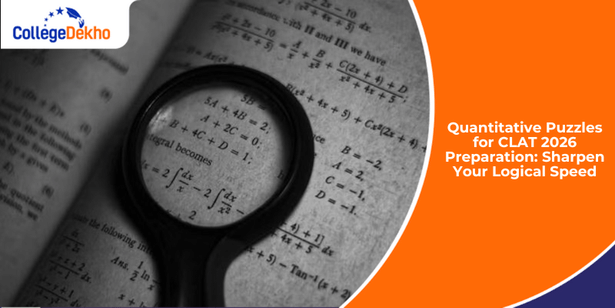
Quantitative puzzles for CLAT 2026 preparation are an easy and reliable way to sharpen your logical reasoning speed before the exam. These puzzles and problems are designed specifically to test your skills during a timed, competitive exam, and therefore, the difficulty level of these questions is moderate to time consuming. That being said, you must use these puzzles regularly to not only enhance your skills for CLAT 2026 but also to check how quickly and effectively you can tackle them, either during mock tests or self-assessment.
Also Read: Time Management Tricks for CLAT 2026 Exam
Quantitative Puzzles for CLAT 2026
If you are looking for some puzzles and problems to test and enhance your mental maths and quantitative abilities, check the following out:
Simple Ratio (Difficulty Level: Easy)
Q: A and B share money in the ratio 5:3. After A gives ₹120 to B, the ratio becomes 4:3. What was A’s original amount?
Solution:
Let original amounts be 5x and 3x. After transfer: A = 5x − 120, B = 3x + 120. Ratio (5x − 120) : (3x + 120) = 4 : 3.
So 3(5x − 120) = 4(3x + 120) → 15x − 360 = 12x + 480 → 3x = 840 → x = 280.
A’s original = 5x = 5×280 = ₹1400.
Answer: INR 1400.
Percentage & Approximation (Difficulty Level: Easy–Medium)
Q: Price of an item is increased by 20% then a discount of 20% is given on the new price. What is the net change in price?
Solution: Let price = 100. After a 20% increase → 120. Then 20% discount on 120 → 120×0.8 = 96. Net change = 96 − 100 = −4 → 4% decrease.
Answer: 4% decrease.
Number Properties (Difficulty Level: Medium)
Q: A two-digit number when increased by the sum of its digits becomes 99. Find the number.
Solution: Let number = 10a + b. Sum digits = a + b. So (10a + b) + (a + b) = 99 → 11a + 2b = 99. Rearr: 11a = 99 − 2b → a = (99 − 2b)/11. RHS integer → 99 − 2b is divisible by 11. Compute 99 mod11 = 0, so 2b ≡ 0 (mod11) → 2b ≡ 0 → b ≡ 0 (mod11) since 2 is invertible mod11 (inverse 6). So b = 0 or 11 (but digit ≤9). So b = 0. Then 11a + 0 = 99 → a = 9. Number = 90. Check: 90 + 9 + 0 = 99.
Answer: 90.
Algebra (Difficulty Level: Medium)
Q: x + y = 9 and x² + y² = 41. Find xy.
Solution: (x + y)² = x² + y² + 2xy → 9² = 41 + 2xy → 81 = 41 + 2xy → 2xy = 40 → xy = 20.
Answer: 20.
Ratio & Mixture (Difficulty Level: Medium)
Q: Two liquids A and B in a ratio of 5:3 are mixed to make 160 litres. If 20 litres of the mixture is removed and replaced by A, the ratio becomes 13:9. Find the original quantities of A and B.
Solution: Original A = (5/8)×160 = 100 L; B = 60 L. After removing 20 L of mixture, removal keeps ratio 5:3 → removed A = 20×5/8 = 12.5 L, removed B = 7.5 L. Remaining A = 100 − 12.5 = 87.5; B = 60 − 7.5 = 52.5. Then add 20 L of A → A = 87.5 + 20 = 107.5; B = 52.5. New ratio = 107.5:52.5 = divide both by (divide by 0.5) → 215:105 = divide by 5 → 43:21 — that is not 13:9. Compute properly: 13:9 corresponds to ratio 13/9 ≈ 1.444...; 107.5/52.5 ≈ 2.0476. So something off: maybe original total = 160 and removal replaced by A should yield the ven ratio — we can set up algebra. Let original A = 5k, B = 3k, total 8k = 160 → k = 20 → A=100, B=60 (as above). After process A_new = 100 − (20×5/8) + 20 = 100 −12.5 +20 =107.5. B_new = 60 − (20×3/8) = 60 −7.5 =52.5. Ratio = 107.5:52.5 = multiply both by 2 → 215:105 = divide by gcd 5 → 43:21. So ratio 43:21 ≠ 13:9. Therefore, the given final ratio 13:9 conflicts with the initial ratio 5:3 for 160 L. So the question as posed is inconsistent. If instead the final ratio is 43:21, it would match.
Answer: Original A = 100 L, B = 60 L. (Given final ratio 13:9 is inconsistent.)
Make sure to include these questions in your CLAT practice sessions. Check the links below to learn more about CLAT 2026!
Related Articles:
Simple Steps to Create a Daily Current Affairs Journal for CLAT 2025 | |
|---|---|
How Meditation and Relaxation Techniques Can Boost Your CLAT Prep |
For any admission-related guidance, call our toll-free number 1800-572-9877, or fill out our Common Application Form (CAF) . Stay tuned with CollegeDekho for more updates related to UG/ PG admissions and colleges!
Are you feeling lost and unsure about what career path to take after completing 12th standard?
Say goodbye to confusion and hello to a bright future!

FAQs
The CLAT Quant section is crucial because it assesses the ability to apply basic maths logically, improves overall score, and, even with fewer questions, can significantly raise rank through clever attempts and high accuracy.
You can find Quantitative Puzzles for CLAT 2026 preparation in CLAT past year papers, CLAT preparation books, online practice platforms, coaching institute materials, and mock test series focusing on data interpretation, logic, and arithmetic reasoning.
Yes, skip tough quantitative puzzles initially to save time. Focus on easy-to-moderate sets for accuracy. Revisit difficult ones later if time permits, ensuring balanced attempts across all sections.
Quantitative puzzles in CLAT 2026 carry about 10% weightage, with 13–17 questions out of 120. These puzzles test basic arithmetic, logic, and data interpretation through short sets, tables, graphs, and caselets.
The type of Quantitative puzzles asked during CLAT 2026 include data interpretation, ratios, percentages, averages, time-speed-distance, work, profit-loss, and approximation-based sets framed as logical, graph, or table-based reasoning rather than direct calculations.
Was this article helpful?





















Similar Articles
Can I pursue JD in the US after BA LLB from India?
Private Law Colleges in India Accepting AILET Scores
Delhi LLB Admission 2026
AILET 2026 Expected Cutoff for All Categories
What is a Good Score in AILET 2026?
AILET 2026 Expected Closing Cutoff Ranks for All Categories